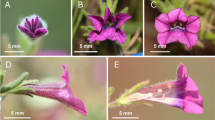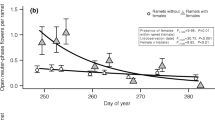Abstract
Heteranthery is thought to reflect a division of labor, with some anthers serving a pollinator-feeding function and others serving a pollinating function. Mutualism theory predicts that each participant should try to maximize the benefit it receives from its partner: plants should allocate more pollen to pollination, and pollinators should collect more pollen. Accordingly, plant and pollinator may engage in a ‘tug of war’ with respect to pollen from each anther type, resulting in incomplete division of labor. Here, we explored this idea by conducting a fully factorial manipulation of the availability of pollen in long and short anthers of staminate flowers of Solanum houstonii. We found the following: (1) Bumble bees (Bombus impatiens) preferred to sonicate (collect pollen from) short anthers over long anthers, consistent with a role as feeding and pollinating anthers, respectively; (2) Blocking short anther pores alone increased sonication of long anthers and resulted in collection of pollen from long anthers; (3) Blocking long anther pores alone did not influence sonication of short anthers; (4) The increase in sonication of long anthers, when short anther pores are blocked, was greater when pollen was available in long anthers; (5) Despite shifting sonication effort to long anthers, bees do not move their bodies closer to long anther pores where pollen could be collected more effectively; and (6) analysis of the growth of corbicular loads over time spent buzzing indicates that significant amounts of pollen are collected from long anthers as well as short anthers. We conclude that bees can flexibly increase pollen collection from pollinating anthers, but are constrained from fully exploiting this pollen. This results in checks and balances between plant and bee that may help maintain heteranthery.





Similar content being viewed by others
References
Barrett SCH (2010). Darwin’s legacy: the forms, function and sexual diversity of flowers. Phil Trans Roy Soc B-Biol Sci 365:351–368
Bohs L, Weese T, Myers N, Lefgren V, Thomas N, Wagenen AV, Stern S (2007) Zygomorphy and heteranthery in Solanum in a phylogenetic context. Act Hort 745:201–224
Bowers KAW (1975) The pollination ecology of Solanum rostratum (Solanaceae). Am J Bot 62:633–638
Buchmann SL (1983) Buzz pollination in angiosperms. In: Jones CE, Little RJ (eds) Handbook of experimental pollination biology. Scientific and Academic Editions, New York, pp 73–113
Buchmann SL, Cane JH (1989) Bees assess pollen returns while sonicating Solanum flowers. Oecologia 81:289–294
Burkart A, Lunau K, Schlindwein C (2011) Comparative bioacoustical studies on flight and buzzing of neotropical bees. J Poll Ecol 6:118–124
De Luca PA, Vallejo-Marín M (2013) What’s the ‘buzz’ about? the ecology and evolutionary significance of buzz-pollination. Curr Opin Plant Biol 16:429–435
De Luca PA, Bussiere LF, Souto-Vilaros D, Goulson D, Mason AC, Vallejo-Marín M (2013) Variability in bumblebee pollination buzzes affects the quantity of pollen released from flowers. Oecologia 172:805–816
Doebeli M, Knowlton N (1998) The evolution of interspecific mutualisms. Proc Natl Acad Sci USA 95:8676–8680
Gross CL, Kukuk PF (2001) Foraging strategies of Amegilla anomola at the flowers of Melastoma affine -no evidence for separate feeding and pollinating anthers. Act Hort 561:171–178
Hargreaves AL, Harder LD, Johnson SD (2009) Consumptive emasculation: the ecological and evolutionary consequences of pollen theft. Biol Rev Cambr Phil Soc 84:259–276
Hrycan WC, Davis AR (2005) Comparative structure and pollen production of the stamens and pollinator-deceptive staminodes of Commelina coelestis and C. dianthifolia (Commelinaceae). Ann Bot 95:1113–1130
King MJ, Buchmann SL (1996) Sonication dispensing of pollen from Solanum laciniatum flowers. Funct Ecol 10:449–456
Leigh EG Jr, Rowell TE (1995) The evolution of mutualism and other forms of harmony at various levels of biological organization. Ecologie 26:131–158
Levin RA, Myers NR, Bohs L (2006) Phylogenetic relationships among the “spiny solanums” (Solanum subgenus Leptostemonum, Solanaceae). Am J Bot 93:157–169
Lunau K, Piorek V, Krohn O, Pacini E (2015) Just spines—mechanical defense of malvaceous pollen against collection by corbiculate bees. Apidologie 46:144–149
Luo Z, Zhang D, Renner SS (2008) Why two kinds of stamens in buzz-pollinated flowers? experimental support for Darwin’s division-of-labour hypothesis. Funct Ecol 22:794–800
Maynard Smith J, Szathmáry E (1995) The major transitions in evolution. WH Freeman, New York
Michener CD (1962) An interesting method of pollen collecting by bees from flowers with tubular anthers. Rev Biol Trop 10:167–175
Muller F (1883) Two kinds of stamens with different functions in the same flower. Nature 27:364–365
Paulino JV, Mansano VF, Prenner G (2016) Evidence for division of labor and division of function related to the pollen release in Papilionoideae (Leguminosae) with a heteromorphic androecium. Int J Plant Sci 177:590–607
Russell AL, Golden RE, Leonard AS, Papaj DR (2016a) Bees learn preferences for plant species that offer only pollen as a reward. Behav Ecol 27:731–740
Russell AL, Leonard AS, Gillette HD, Papaj DR (2016b) Concealed floral rewards and the role of experience in floral sonication by bees. Anim Behav 120:83–91
Sanchez MGB (2011) Taste perception in honey bees. Chem Senses 36:675–692
Sutton GP, Clarke D, Morley EL, Robert D (2016) Mechanosensory hairs in bumblebees (Bombus terrestris) detect weak electric fields. Proc Natl Acad Sci USA 113 (26):7261–7265
Tang Y, Xie J-s, Sun H (2007) Pollination ecology of Pedicularis muscoides H. L. Li subsp. himalayca Yamazaki from alpine areas of western Sichuan, China. Arct Antarc Alp Res 39:481–487
Vallejo-Marín M, Manson JS, Thomson JD, Barrett SCH (2009) Division of labour within flowers: heteranthery, a floral strategy to reconcile contrasting pollen fates. J Evol Biol 22:828–839
Vallejo-Marín M, Da Silva EM, Sargent RD, Barrett SCH (2010) Trait correlates and functional significance of heteranthery in flowering plants. New Phytol 188:418–425
Vallejo-Marín M, Walker C, Friston-Reilly P, Solís-Montero L, Igic B (2014) Recurrent modification of floral morphology in heterantherous Solanum reveals a parallel shift in reproductive strategy. Phil Trans R Soc B 369:20130256
Westerkamp C (1996) Pollen in bee-flower relations: some considerations on melittophily. Bot Acta 109:325–332
Acknowledgements
We thank Heather Gillette for help with bee flight arena observations, Kevin Mauerman for assistance with video transcriptions, Abreeza Zegeer for plant maintenance, and two anonymous reviewers for comments. The work was funded by NSF award no. 1257762. We thank Keith Brust for use of a photograph. We gratefully dedicate this paper to the memories of two incredible scientists who studied buzz pollination and “solanoid” type flowers with pored anthers, American melittologist Charles D. Michener and German botanist Stefan Vogel. Charles Michener was one of the first biologists to observe and report on this interesting method of pollen collecting behavior by certain bees.
Author information
Authors and Affiliations
Corresponding author
Additional information
Handling Editor: Heikki Hokkanen.
Electronic supplementary material
Below is the link to the electronic supplementary material.
Rights and permissions
About this article
Cite this article
Papaj, D.R., Buchmann, S.L. & Russell, A.L. Division of labor of anthers in heterantherous plants: flexibility of bee pollen collection behavior may serve to keep plants honest. Arthropod-Plant Interactions 11, 307–315 (2017). https://doi.org/10.1007/s11829-017-9497-5
Received:
Accepted:
Published:
Issue Date:
DOI: https://doi.org/10.1007/s11829-017-9497-5




